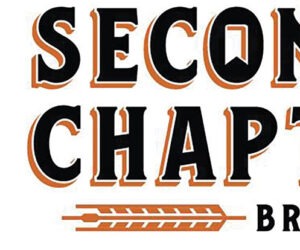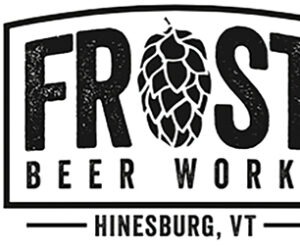Brewing With Russian River
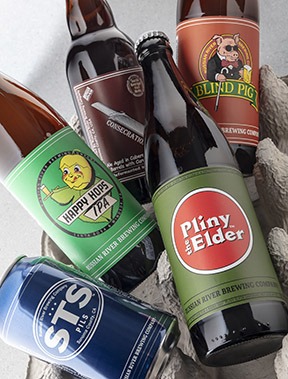
Maybe it’s a regional bias, but to me Russian River Brewing Co. (RRBC) is the “Grand Cru” of craft beer. Before we go any further, let’s qualify that statement. I’m not talking about the literal French meaning “great growth,” but that applies to them as well. I mean it from a craft beer-inspired standpoint — the best of the best. Every beer is beautifully executed to style, but also has an extremely high level of creativity and nuance. Their beers have long been some of the most hyped — playing a big role in beginning the trend of beer trading by aficionados online and waiting in lines for hours for the opportunity to buy a small allotment of a special release — and most recognized in the world’s largest beer competitions. Almost three decades since opening, they’re still as popular as ever before.
The story of Russian River actually begins further back. It starts with the Owners Vinnie and Natalie Cilurzo. Vinnie started homebrewing in the late 1980s and instantly knew he wanted to become a brewer. In fact, on the couple’s first date in the early 1990s, Natalie asked Vinnie what he wanted to do with his life, and he said he wanted to own a brewery.
Within a few years the couple made that dream a reality. Vinnie was able to find an investor (and business partner) to help fund the build-out and Natalie kept the young couple afloat with her job in the wine industry. After procuring some used equipment in Arizona, Vinnie founded Blind Pig Brewing in Temecula, California, in 1994.
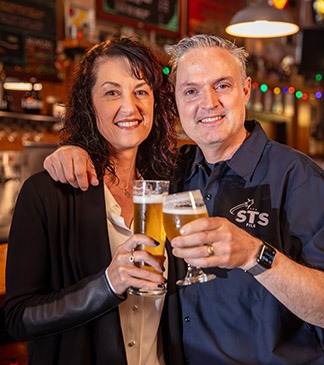
From his very first batch, Vinnie was making waves in the craft beer industry. There, he brewed what is cited as the first modern double IPA (while also coining the term) — you can read more about this in the sidebar, below. His beers defined the style guidelines for DIPA as we know it today. He went on to win many awards at Blind Pig before the couple made the move to Sonoma County in Northern California.
As Vinnie wrapped up his part at Blind Pig in early 1997, similar to the old saying, “when one door closes, another one opens” Vinnie had heard from one of his vendors that Korbel Winery wanted to open a brewery, so he had reached out to them about a position. He was soon hired by Korbel to run their newly founded Russian River Brewing Company. Going from an old, cobbled together brew system at Blind Pig to a new, highly functional and beautiful stainless and copper system at Russian River, Vinnie started to really hone his skills as a brewer. He continued to win awards and make amazing beers, specifically dialing in the IPA style.
After several years, Korbel decided they wanted to focus on their primary business and planned to sell the brewery. Vinnie was able to work out a deal with them and acquired the brand and many of the assets in the process. After that and another round of finding investors and building out a new brewpub, the couple officially opened Russian River Brewing Co. in downtown Santa Rosa, California, (known locally as the “OG location”) on April 3, 2004. In 2008, they built a production facility to keep up with demand as sales outpaced what they could produce at the brewpub. By 2016, after years of tremendous success, the couple was able to buy out the last of their investors and own the entire company themselves. This allowed them to finally build what Vinnie calls their “dream brewery” in Windsor, California, just a short drive from the original 4th Street brewpub (I highly recommend doing what I call the Russian River Two-Step and grabbing a beer and bites from both locations in one day).
Refering to the Windsor location as a “dream brewery” definitely fits the bill. The Cilurzos meticulously planned and assembled a team of engineers to design not only a beer production facility, but also a customer-focused experience that is nothing short of world-class on both fronts. Both guided and self-guided brewery tours allow you to look over the production facility and beautiful open-top fermenters, not to mention the chapel-esque koelschip (coolship) room, to the family- and dog-friendly dining areas, it is a magical place like a craft-beer Disneyland.
Surrounding the facility are picturesque rolling hills and vineyards. In regards to the surrounding area and the brewery’s history, I would be remiss without mentioning how important and impactful Natalie and Vinnie have been. They’re both passionate about giving back to the community and in 2017, when devastating wildfires struck Sonoma County, they quickly mobilized and coordinated with other breweries to raise $1.1 million for fire victims. They also both work and advocate within the craft beer industry, working with brewing associations, hop growers, and more for the betterment of craft beer as a whole. Not to mention how much of a positive financial impact the brewery has on the surrounding area from a beer destination standpoint!
————————
Creating the Double IPA (sidebar)
Vinnie: “The first beer I brewed (at Blind Pig Brewing) was a double IPA. I took my homebrew recipe, and I didn’t know how to scale it up. So I called Vince Marsaglia. Vince and his sister Gina owned Pizza Port of San Diego at the time. I’d go down there and hang out and just get inspired by what they had done. And so, he gave me the recipe for Swami’s. He knew I wasn’t going to just copy it. I used it as a guide to extrapolate my homebrew recipe up. And so, you know, the first beer we made was a double IPA instead of a regular IPA with the idea that, well, we make a bigger beer, more hops basically, you know, in all honesty, to cover up any flaws as long as it wasn’t contaminated.”
Vito: “Let’s go back to talk about double IPA, because you’re credited as the inventor of that style, right?”
Vinnie: “So they say.”
Vito: “So that beer, it sounds like you intended for it to be a double?”
Vinnie: “I did. Yeah, we doubled the hops, raised the malt up. We weren’t using any sugar; it was all malt and that was probably mostly based on what I kept reading in the stuff from Fritz Maytag at Anchor saying. I think he was referring to English brewers sometimes using sugar in the past and how he wanted to be all malt. I was very much inspired and influenced by Fritz and Ken Grossman (of Sierra Nevada), of course. So it was all malt, the finishing gravity was quite a bit higher than what I would do today, but it was an over-the-top, hoppy beer. It was so bitter. It was like bracingly bitter, it was measured in a lab at 120 IBU. I always said ‘double IPA’ because we had doubled the hops and it made more sense to me. But ‘imperial’ works too.”

The Crown of Windsor: Open-Top Fermenters & Koelschip
Like a modern-day Camelot of craft beer, Vinnie and the team at RRBC have several crown jewels of brewing equipment you don’t see at most breweries. First and foremost, they have seven open-top fermenters, or OTFs for short. Open-top fermentation is an older traditional way to ferment beer. Many classic European breweries and some stateside ones (most notably, the now defunct Anchor Brewing in San Francisco) have them.
“Open-top fermenters traditionally are 1-to-1 ratio, so their tank geometry is that they’re as wide as they are tall. So there’s a lot less head pressure on the beer even when there’s no lid. The weight of the liquid creates pressure. So with the 1-to-1 ratio, you have very little pressure there. The yeast ferments a lot healthier and its viability is usually quite a bit higher. There’s a lot of positives to open-top fermentation,” Vinnie explains.
OTFs offer several benefits due to a shape that is different from most conical fermenters, but they can be more labor intensive to work with. The ones at RRBC also have another unique feature you do not see at most places that have OTFs. They’re set up to top crop and harvest yeast from the kräusen.
“At the top in that foam is what the Germans call the brandhefe. It’s basically like just a mix of dead yeast cells and polyphenols, or maybe trub that got through the heat exchanger and that will get trapped in the foam,” Vinnie said. “To me, the best reason to open-top ferment is that you can go in and skim that. So, by skimming that you’re skimming off some of the (contributors to) harsh flavors and whatnot, particularly in lager beer.”
Another reason for open-top fermentation is ester promotion, which Vinnie said he appreciates.
“It isn’t a bad thing even for lagers because you’re at a lower temperature. Belgian beers (in open-top fermenters) are just amazing,” he said.
Vinnie offered that homebrewers could attempt to mimic an open-top fermenter by filling your fermenter half full and leaving head space.
Related to open fermentation and on the other side of the brewery is a huge ornate door that leads to the koelschip room (Vinnie prefers the Flemish spelling). If you’re a fan of lambic, you probably know what this is for. If not, it’s essentially a wide, yet shallow, open-top vessel to collect wort into. The wort cools and undergoes an ambient inoculation. I’ll let Vinnie take it from here:
“Another part of our funky beer production is spontaneous beer. I’ve been to Belgium probably a dozen-plus times and my first trip I was 19 years old. I went to Cantillon and was really just blown away that you could make beer that way. Years later, I took another trip with some brewer friends, and came back very inspired to make beer. That was in 2005, I believe, and I started doing it at our Santa Rosa pub, just in an old Grundy that I had removed the lid. I eventually put in a koelschip there, it is a little different shape than what you see now at our Windsor Brewery or anywhere in Belgium.
“So there’s a lot of science behind it, and if you do the same thing year in and year out, you can really hone in the process and get some consistency. But I love the blending aspect of it. It’s got a very winemaking (feel to it). And so we now have a koelschip here at our Windsor facility also, which is more of a traditional koelschip, where the air comes in and cools the wort off. It’s a very shallow vessel, only like 10 or 12 inches in it. And then the cool air comes in, cools it off, and then inoculates the wort that eventually goes into the barrels.
“In time, it will start fermenting and could age up to three years. Then we’ll do a disproportionate blend of different years of what we call Sonambic, because it’s Sonoma and lambic contracted together. Lambic is a protected word and it’s also just out of respect for our brewer friends in Belgium.”
World-Class Beers: The White Whales
Having a dream, building an amazing brand, a beautiful destination, and being great people are not the only keys to success. To quote a great from the music industry “It don’t mean a thing, if it ain’t got that swing.” First and foremost, the beer has to be great. That may be an understatement when describing RRBC beers. Even other local commercial brewers that I consider “great” are in awe of the beers RRBC is turning out and often use them as a starting point and measuring block for their own creations.
And it’s not just us locals who are head over heels for their beers. National and international beer review publications consistently rate their offerings among the best beers. And for those who may know and only associate Russian River with their IPAs, it’s not just the hoppy beers that are widely praised. Their Belgian styles, barrel-aged sours, and lagers are all world class. To consistently brew every style of beer with such a high level of execution and win awards in multiple style categories speaks to the level of passion and expertise among the team at Russian River. Although, I think we can all agree it was their hoppy beers that put them on the map.
Recalling back to around 2010 or so, I remember the local bottle shops that would get Russian River’s beers having purchase limits on Pliny the Elder. People would find out what day they got their deliveries and line up before the store even opened to grab their limit of bottles before the store inevitably sold out of them.
————————-
What’s with the Name? (sidebar)
Pliny the Elder was created in 1999 as Vinnie needed to brew a double IPA for the first ever Double IPA Fest organized by The Bistro in Hayward, California. Vinnie knew he wanted to enter a beer
as he was already selling beer
to The Bistro and had been brewing double IPAs for years. I’ll let
Vinnie tell the rest of the story of
how Pliny the Elder (and Younger) were named. . .
“We created a recipe, and we needed a name. So we were first thinking about something that had to do with big, big flavors, you know, like a double IPA would be. Names like the Mammoth, etc., but that was already taken by Mammoth Brewing Company. Then we started thinking about things like large wine bottles, (biblical patriarch) Methuselah, (king of ancient Babylon) Nebuchadnezzar . . . We wanted a name that would take on its own personality, and we started looking through this old dictionary we had that the Brewers Association had published and we looked up hops and the original botanical name. Then in that reference we saw the name, Pliny the Elder. So we looked him up and it turns out that he and his contemporaries had written about hops and were, if not the first, some of the early people to write about hops. He died at the eruption of Mount Vesuvius. A lot of what we know about Vesuvius was through him and his writings. But it was his nephew and adopted son, Pliny the Younger, who wrote a lot of what we know about Pliny the Elder.
“That’s where the name came from because he wrote about hops, and so it seemed like an odd name for a beer.”
—————————
Though, those lines at bottle shops paled in comparison to the lines for the far more elusive Pliny the Younger, which is released just once a year and attracts people from around the globe. Pliny the Younger is a triple IPA that uses similar hops as Pliny the Elder, but at much larger quantities. It has an intense citrus, stone fruit, and pine aroma and flavor. These are reminiscent of what you smell and taste in Pliny the Elder, but at much higher levels. The striking thing about Pliny the Younger is that you really don’t taste any of the 10.25% ABV in the beer. It is incredibly balanced, dry, and drinkable for such a big beer.
During its height, you would see people selling growlers filled with Younger on the internet for hundreds of dollars; it was truly a crazy time. It was, and still is, the “white whale” of craft beer. Though neither Elder (first brewed in 1999) nor Younger (first brewed in 2005) were nearly as popular at their origins.
“It didn’t take off initially. It was a very slow burn. Eventually, when Elder became popular was in 2008 and it wasn’t until 2010 for Younger,” Cilurzo recalls.
Younger was a product of Vinnie wishing to push the boundaries and do something different in the winter months from the barleywines that many other breweries were releasing, and perhaps pass some time in the slow season for a brewery that was just getting by.
“It was Natalie and I, and it was pretty slow. You know, we weren’t paying ourselves and it was a slow time of winter for beer, so we were just looking for ways to fill the tanks, make a little extra beer, and a little extra income at the time,” Vinnie said. “I had this idea to push the envelope and see how hoppy we could make a beer and still have a drinkable balance.”
Vinnie first contemplated making Younger a beer that was lower in alcohol than Elder, which is 8% ABV, with the thinking that the hops would pop more with a lower-ABV beer. Though after further consideration, he went higher in alcohol for better balance.
“At the time it started at 11% alcohol. Eventually it moved. We brought it down to 10.25%, which is where it is now,” Vinnie said. “So basically just more base malt and then more sugar . . . and then literally taking the hops and adding 50 or 100% more than the Elder.”
Getting such a big beer not to finish too sweet was the next challenge. “You have to remember, alcohol adds sweetness. And that was in part why we eventually brought it to 10.25%, but (it had to be) a beer that was really dry. That was a cornerstone of all of our beers, that they are dry,” Vinnie said.
“From 2005 to 2009, we would release it in early February with no fanfare, nobody waiting in line. Then in 2010, I showed up to tap the first keg, and lo and behold — it’s 7 a.m., by the way, so we’re four hours from opening — and I look outside. There’s people mingling out front. So I get the beer tapped and I look out and there’s even more people out front,” Vinnie recalls. “So I go outside and say, ‘hey, what’s going on?’ They said, ‘oh, we’re here for Pliny the Younger.’ And I said, ‘Well, you know, it’s 7 a.m. we don’t open until 11.’ And they said, ‘Yeah, that’s fine. We really want to taste it. There’s a website that has it ranked as the best beer in the world and another website has it as the second best beer.’”
“RateBeer had it as number one and BeerAdvocate had it at number two behind Westvleteren. They’re like, ‘we want to make sure to have it.’ And I was like, ‘you know, we have a lot of it.’”
Vinnie still isn’t sure how the beer rating websites found out about Pliny the Younger. He admits he hadn’t even heard of either site prior to that day. “You know, we only sold it on draft at our little brew pub in Santa Rosa. But somewhere along the way people were coming in and drinking it and it was somehow getting highly rated,” Vinnie said.
“That day we sold all 620 gallons (2,350 L) in eight hours! It was our busiest day ever,” Vinnie said. “I had to literally drill a hole in the cold box in the back to fill more growlers because we were selling so many. Natalie was at the front with a couple of bartenders and any employees that came in that day we just put them to work. Friends that came in we put them to work. And we were able to buy a 200-barrel fermenter because of that day.”

Along with the out of nowhere success and rush he felt, Vinnie also recalls the regret of being ill prepared for such a showing. “It was the worst customer service,” he said. “But literally, that day was when we started. That’s when the event built from that day I was like, ‘OK, next year we’re going to spread it out over two weeks and we’re going to have a limit and we may run out at the end of the day, but you’ll know for sure you can come back the next day and get some.”
The release still draws lines around the brewery before it opens — Vinnie himself often greeting and chatting with customers in line. Beyond being prepared, another thing that has changed is actually the recipe itself — which Vinnie says changes every year. That, and the fact that it is brewed using ingredients such as hop extracts that are not currently available in homebrew quantities, is why we’re passing on providing a clone recipe in this story.
Younger may be unique in that the recipe changes every year, however recipe tweaks to brands that have been around for decades isn’t uncommon at Russian River. Even the beers that are beloved and consistently rated among the best by those people who rate beers have changed when Vinnie feels they are warranted.
“It’s something that I think has kept our beers relevant still; that if you stick with the exact same recipe that you did 10, 20 years ago, you know, if you’re lucky to be in business that long, you’re not being relevant to the current consumers,” Vinnie said. “We have made tweaks along the way to our recipes, like Blind Pig IPA. It no longer has any crystal malt in it. Pliny used to have some dextrin malt that is no longer in the recipe.”
To learn what is in these recipes now, Vinnie was gracious enough to provide clone recipes of five of our favorite Russian River beers. So even if you can’t get your hands on these elusive beers that are only distributed to a handful of states, you can now brew your own.
Russian River Brewing Co.’s Blind Pig IPA clone

(5 gallons/19 L, all-grain)
OG = 1.057 FG = 1.009
IBU = 80 SRM = 5 ABV = 6.25%
“My first version of Blind Pig IPA was in 1994 at my very first brewery, Blind Pig Brewing Company, which was located in Temecula, California. This recipe originated from my homebrew days starting in 1989. Years later after Natalie and I took over Russian River Brewing Company from my former employer, Korbel Champagne Cellars, we were able to obtain the trademark for Blind Pig IPA so we brought her back to life.” – Vinnie Cilurzo
Ingredients
11 lbs. (5 kg) 2-row pale malt
10 oz. (283 g) wheat malt
3 oz. (85 g) dextrin malt}
13 AAU Chinook hops (60 min.) (1 oz./28 g at 13% alpha acids)
10.5 AAU Centennial hops (15 min.) (1 oz./28 g at 10.5% alpha acids)
3 AAU Cascade hops (15 min.) (0.5 oz./14 g at 6% alpha acids)
0.4 oz. (11 g) Amarillo® hops (whirlpool)
0.75 oz. (21 g) Cascade hops (whirlpool)
0.5 oz. (14 g) Centennial hops (whirlpool)
0.4 oz. (11 g) Crystal hops (whirlpool)
0.8 oz. (22 g) Simcoe® hops (whirlpool)
0.4 oz. (11 g) Amarillo® hops (dry hop)
0.75 oz. (21 g) Amarillo® CGXTM hops (dry hop)
1 oz. (28 g) Centennial hops (dry hop)
0.50 oz. (14 g) Citra® CryoTM hops (dry hop)
0.4 oz. (11 g) Chinook hops (dry hop)
0.7 oz. (20 g) Crystal hops (dry hop)
0.14 oz. (4 g) Nectaron® hops (dry hop)
Wyeast 1056 (American Ale), White Labs WLP001 (California Ale), or SafAle US-05 yeast
¾ cup corn sugar (if priming)
Step by step
Mash the grains at 156 °F (69 °C) for 60 minutes, targeting a mash pH of 5.35–5.45. Conduct a 170 °F (77 °C) mash out step, if desired. Vorlauf until your wort is clear, then run off into the kettle. Sparge the grains with 168 °F (76 °C) water to obtain 6 gallons (23 L) of wort (or more, depending on your evaporation rate).
Boil for 60 minutes following the hopping schedule. After the boil is complete, add the whirlpool hop additions and stir the wort briskly to form a whirlpool, then cover and let stand for 15 minutes. Russian River adjusts the pH in the whirlpool down to 5.0–5.1.
Chill the wort to slightly below fermentation temperature, about 64–66 °F (18–19 °C). Aerate the wort if using a liquid yeast strain, pitch the yeast, and add yeast nutrient if desired. Ferment at 68 °F (20 °C) until final gravity is achieved and let the beer sit for one to two additional days.
If possible, remove yeast from fermenter before adding the dry-hop additions. If able, after three more days, dump the cone of your fermenter to remove as much dry hops and yeast as possible.
Before the dry hop, Vinnie Cilurzo recommends taking a gravity reading of the beer and recording it in your brew log. This exercise will be particularly helpful as it relates to hop creep. Three days after dry hopping, take a gravity reading and note it. Do the same the following day. Once you go two days in a row where your gravity has not dropped from the secondary fermentation from hop creep, you can proceed with chilling the beer and/or bottling or kegging. Depending on your conditions, you might have to wait longer to clear hop creep. Bottle or keg and force carbonate as usual.
Extract version:
Replace the 2-row, dextrin, and wheat malts with 7.3 lbs. (3.3 kg) light liquid malt extract and 8 oz. (230 g) dry wheat malt extract. Add 6.5 gallons (24.5 L) water to your brew kettle and bring to a boil. Remove kettle from heat and carefully stir in the liquid and dry malt extracts until totally dissolved. Return to boil and boil for 60 minutes. Follow the remainder of the all-grain recipe.
Notes from Vinnie:
At our Windsor, California, production brewery we incorporate whole cone hops into the final hop addition. This is done by way of a hop back where the wort runs from our whirlpool, over the whole cone hops in the hop back, and from there the wort gets cooled off and heads to the fermenter.
Over the years the recipe has changed some. In the past there was about 3% crystal malt (40 °L) in the recipe but as you can see, there is now no crystal malt, leaving the beer leaner and thus allowing the hops to pop more.
I look at a beer recipe more as a concept rather than a strict recipe. With that said, over the years some of the hops have changed so you will see some more modern hops in Blind Pig IPA now. Crystal hops are often not thought of as an IPA hop, but it can contribute a nice citrus note to a brew, which I like. In my opinion, this has kept the beer relevant even after all these years.
Finally, feel free to brew this recipe as is, but if you can’t find a particular hop, don’t stress over it. Find something similar and experiment and explore — that is what homebrewing is all about. Also, since this beer is on the lower side of the alcohol range for an IPA, if you like a little more malt body in the beer, I’d suggest removing some of the 2-row malt and replace it with Simpsons Best Pale Ale malt, which will add more malt body to the finished beer.
Russian River Brewing Co.’s Pliny the Elder clone
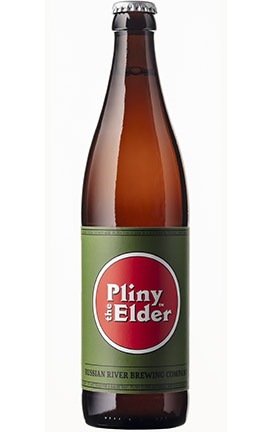
(5 gallons/19 L, all-grain)
OG = 1.069 FG = 1.009
IBU = 100 SRM = 5 ABV = 8%
We first made Pliny the Elder in 1999, initially for a Double IPA festival at The Bistro in beautiful downtown Hayward, California. Previous to that, in 1994 I had made what is now considered to be the first modern double IPA in recent brewing history. So making a big, over-the-top IPA was not something new to me. In 2004, after Natalie and I took over Russian River Brewing Company . . . Pliny the Elder became a year-round beer and quickly became our top selling beer, which it still is today. – Vinnie Cilurzo
Ingredients
13 lbs. (5.9 kg) 2-row pale malt
13 oz. (370 g) corn sugar
21 AAU Warrior hops (60 min.) (1.35 oz./38 g at 15.5% alpha acids)
4 AAU Amarillo® hops (15 min.) (0.42 oz./12 g at 10% alpha acids)
17 AAU Simcoe® hops (15 min.) (1.4 oz./40 g at 12% alpha acids)
1.1 oz. (31 g) Cascade hops (whirlpool)
1 oz. (28 g) Simcoe® hops (whirlpool)
0.7 oz. (20 g) Amarillo® hops (whirlpool)
0.68 oz. (19 g) Centennial hops (whirlpool)
0.7 oz. (20 g) Amarillo® hops (dry hop)
0.35 oz. (10 g) Amarillo® CGXTM hops (dry hop)
0.5 oz. (14 g) Citra® hops (dry hop)
0.5 oz. (14 g) Citra® CryoTM hops (dry hop)
0.9 oz. (26 g) Crystal hops (dry hop)
0.28 oz. (8 g) Chinook hops (dry hop)
1.55 oz. (44 g) Simcoe® CryoTM hops (dry hop)
Wyeast 1056 (American Ale), White Labs WLP001 (California Ale), or SafAle US-05 yeast
¾ cup corn sugar (if priming)
Step by step
Mash the grains at 156 °F (69 °C) for 60 minutes, targeting a mash pH of 5.35–5.45. Conduct a 170 °F (77 °C) mash out step, if desired. Vorlauf until your wort is clear, then run off into the kettle. Sparge the grains with 168 °F (76 °C) water to obtain 6 gallons (23 L) of wort (or more, depending on your evaporation rate).
Boil for 60 minutes following the hopping schedule. Add the corn sugar with 15 minutes remaining. After the boil is complete, add the whirlpool hop additions and stir the wort briskly to form a whirlpool, then cover and let stand for 15 minutes. Russian River adjusts the pH in the whirlpool down to 5.0–5.1.
Chill the wort to 62 °F (17 °C). Aerate the wort if using a liquid yeast strain, pitch the yeast, and add yeast nutrient if desired. Ferment at 64 °F (18 °C) until final gravity is achieved and let the beer sit for one to two additional days.
If possible, remove yeast from fermenter before adding the dry-hop additions. If able, after three more days, dump the cone of your fermenter to remove as much dry hops and yeast as possible.
Before the dry hop, Vinnie Cilurzo recommends taking a gravity reading of the beer and recording it in your brew log. This exercise will be particularly helpful as it relates to hop creep. Three days after dry hopping, take a gravity reading and note it. Do the same the following day. Once you go two days in a row where your gravity has not dropped from the secondary fermentation from hop creep, you can proceed with chilling the beer and/or bottling or kegging. Bottle or keg and force carbonate as usual.
Extract version:
Replace the 2-row pale malt with 8.6 lbs. (3.9 kg) light liquid malt extract. Add 6.5 gallons (24.5 L) water to your brew kettle and bring to a boil. Remove kettle from heat and carefully stir in the liquid malt extract until totally dissolved. Return to boil and boil for 60 minutes, following the remainder of the all-grain recipe.
Notes from Vinnie:
I wrote this recipe using Warrior T90 pellets, but in actuality we use Warrior CO2 extract from Yakima Chief Hops. Feel free to make this substitution if you have access to the extract. It could be a different bittering hop extract if you want. The extract reduces the green matter in the kettle, thus raising your yield. It also reduces the vegetal matter contribution to the overall flavor profile of the beer.
At our Windsor, California, production brewery we incorporate whole cone hops into the final hop addition. This is done by way of a hop back where the wort runs from our whirlpool, over the whole cone hops in the hop back, and from there the wort gets cooled off and heads to the fermenter.
Like our Blind Pig IPA, over the years this recipe has changed as well. Same as Blind Pig, there once was a small percentage of crystal malt (40 °L) in the recipe but we removed it, leaving the beer leaner and thus allowing the hops to pop more. I look at a beer recipe more as a concept rather than a strict recipe and, in particular with this recipe, I feel like these changes have kept Pliny the Elder relevant even after 20 years.
When I first published the Pliny the Elder homebrew recipe back in 2005, my goal was to give brewers a starting point with a big, hopped up beer like this. The same goes now! Feel free to brew this recipe as is, but if you can’t find a particular hop, don’t stress over it — find something similar and experiment and explore, that is what homebrewing is all about.
Russian River Brewing Co.’s STS Pils clone
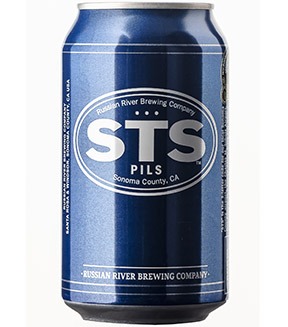
(5 gallons/19 L, all-grain)
OG = 1.048 FG = 1.007
IBU = 32 SRM = 3 ABV = 5.35%
Because STS is dry hopped using European-type hops, it would technically be classified as an Italian-style Pilsner. However, if you read the side label on the STS Pils can, it says it is a Keller-style Pilsner as we treat it as an unfiltered beer, leaving a little yeast and haze behind. – Vinnie Cilurzo
Ingredients
9.5 lbs. (4.3 kg) Dingemans Pilsner malt
4.8 oz. (136 g) acidulated malt
3.4 AAU Aramis hops (first wort hop) (0.4 oz./11 g at 8.5% alpha acids)
3.4 AAU Aramis hops (60 min.) (0.4 oz./11 g at 8.5% alpha acids)
2.8 AAU Hallertau Mittelfrüh hops (15 min.) (0.4 oz./11 g at 4% alpha acids)
0.8 oz. (23 g) Aramis hops (whirlpool)
1.5 oz. (43 g) Aramis hops (dry hop)
0.75 oz. (21 g) Hallertau Mittelfrüh hops (dry hop)
Imperial Yeast L17 (Harvest), White Labs WLP680 (Munich Lager), Wyeast 2352 (Munich II), or SafLager W-34/70
¾ cup corn sugar (if priming)
Step by step
Use a lager water profile with an eye towards being low in minerals. Russian River starts with reverse osmosis water and adds a little calcium chloride and even less gypsum. Target a mash pH of 5.35–5.45 and utilize a thin mash. Conduct a step mash beginning at 132 °F (56 °C) for 20 minutes. Heat to 142 °F (61 °C) and hold for 20 minutes. Heat to 152 °F (67 °C) and hold for 30 minutes. Heat to 162 °F (72 °C) and hold for 20 minutes. Ensure conversion is complete and conduct a 170 °F (77 °C) mash out step, if desired. Vorlauf until your wort is clear, then run off into the kettle. Sparge the grains with 168 °F (76 °C) water to obtain 6 gallons (23 L) of wort (or more, depending on your evaporation rate).
Boil for 60 minutes following the hopping schedule. After the boil is complete, add the whirlpool hop additions and stir the wort briskly to form a whirlpool, then cover and let stand for 15 minutes. Russian River adjusts the pH in the whirlpool down to 5.0–5.1.
Chill the wort to 50 °F (10 °C). Aerate the wort if using a liquid yeast strain, pitch the yeast, and add yeast nutrient if desired. Ferment at 52 °F (11 °C) until final gravity is achieved and let the beer sit for one to two additional days.
If possible, remove yeast from fermenter and reduce temperature to 42 °F (6 °C) before adding the dry-hop additions. If able, after three more days, dump the cone of your fermenter to remove as much dry hops and yeast as possible. Drop temperature to 32 °F (0 °C), or as close as you’re able, and let sit two additional weeks. Bottle or keg and force carbonate as usual.
Extract version:
Replace the Pilsner and acidulated malts with 6.6 lbs. (3 kg) Pilsner liquid malt extract and ½ tsp. 88% lactic acid. Add 6.5 gallons (24.5 L) water to your brew kettle and bring to a boil. Remove kettle from heat and carefully stir in the liquid malt extract until totally dissolved, as well as the lactic acid. Return to boil and boil for 60 minutes, following the remainder of the all-grain recipe.
Notes from Vinnie:
One of my favorite malt companies is Dingemans from Belgium and we use Dingemans Pilsen malt as the base malt in STS Pils and our other lager (and Belgian-inspired) beers. If your homebrew shop doesn’t have Dingemans Pilsen malt, of course another Pilsner malt will do. However, I encourage you to ask the homebrew shop to order some Dingemans Pilsen malt as it is an amazing malt with rich malt character.
Since we first started brewing STS Pils in 2014, the main hop in it has always been Aramis. This is a French hop grown by Hop France. Aramis was originally bred to be a replacement for Strisselspalt for a large, multi-national brewery. In time, this brewery decided not to use it, which opened the door up for smaller breweries like Russian River (and others) to use it. It is one of my favorite hops we use. It is available in homebrew quantities, but if you can’t find Aramis, try to find Strisselspalt or feel free to make a mix of other German hops.
Augustiner yeast is sometimes hard to find as a homebrewer. 34/70 also works great on this beer. Augustiner leaves a slightly fruitier flavor on the palate and if you want this but are using 34/70, you can bump up the temperature a degree or two to get a similar result.
Russian River Brewing Co.’s Happy Hops clone
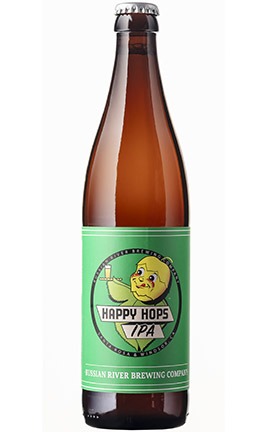
(5 gallons/19 L, all-grain)
OG = 1.058 FG = 1.009
IBU = 45 SRM = 4 ABV = 6.5%
As hazy IPAs were gaining popularity, and before Russian River had brewed Mind Circus, our hazy IPA, I wanted to see if I could brew a beer that had all the juicy notes of a hazy IPA, but that was clear to the look. So Happy Hops became what I jokingly called our, “not so hazy, hazy IPA.” It is more of a progressive/modern IPA in that it has a lower bitterness compared to our other IPAs, but it carries lots of rich, juicy hop notes due to backloading the whirlpool with a sizable hop addition as well as a good size dry hop charge. – Vinnie Cilurzo
Ingredients
10 lbs. (4.5 kg) 2-row pale malt
1.25 lbs. (0.57 kg) Simpsons Best Pale Ale malt
9.5 oz. (270 g) wheat malt
4 AAU Brewers Gold hops (60 min.) (0.5 oz./14 g at 8% alpha acids)
1 oz. (28 g) Amarillo® hops (whirlpool)
2.1 oz. (60 g) Azacca® hops (whirlpool)
2.1 oz. (60 g) Mosaic® hops (whirlpool)
1.5 oz. (42 g) Strata® hops (whirlpool)
1.5 oz. (42 g) Azacca® hops (dry hop)
1 oz. (28 g) Citra® CryoTM hops (dry hop)
1 oz. (28 g) Mosaic® hops (dry hop)
1.5 oz. (42 g) Mosaic® CryoTM hops (dry hop)
0.4 oz. (11 g) Simcoe® CryoTM hops (dry hop)
2 oz. (56 g) Strata® hops (dry hop)
Wyeast 1056 (American Ale), White Labs WLP001 (California Ale), or SafAle US-05 yeast
¾ cup corn sugar (if priming)
Step by step
Mash the grains at 156 °F (69 °C) for 60 minutes, targeting a mash pH of 5.35–5.45. Conduct a 170 °F (77 °C) mash out step, if desired. Vorlauf until your wort is clear, then run off into the kettle. Sparge the grains with 168 °F (76 °C) water to obtain 6 gallons (23 L) of wort (or more, depending on your evaporation rate).
Boil for 60 minutes following the hopping schedule. After the boil is complete, add the whirlpool hop additions and stir the wort briskly to form a whirlpool, then cover and let stand for 15 minutes. Russian River adjusts the pH in the whirlpool down to 5.0–5.1.
Chill the wort to slightly below fermentation temperature, about 64–66 °F (18–19 °C). Aerate the wort if using a liquid yeast strain, pitch the yeast, and add yeast nutrient if desired. Ferment at 68 °F (20 °C) until final gravity is achieved and let the beer sit for one to two additional days.
If possible, remove yeast from fermenter before adding the dry-hop additions. If able, after three more days, dump the cone of your fermenter to remove as much dry hops and yeast as possible.
Before the dry hop, Vinnie Cilurzo recommends taking a gravity reading of the beer and recording it in your brew log. This exercise will be particularly helpful as it relates to hop creep. Three days after dry hopping, take a gravity reading and note it. Do the same the following day. Once you go two days in a row where your gravity has not dropped from the secondary fermentation from hop creep, you can proceed with chilling the beer and/or bottling or kegging. Depending on your conditions, you might have to wait longer to clear hop creep. Bottle or keg and force carbonate as usual.
Extract version:
Replace all of the grains with 7.7 lbs. (3.5 kg) light liquid malt extract and 5 oz. (140 g) dry wheat malt extract. Add 6.5 gallons (24.5 L) water to your brew kettle and bring to a boil. Remove kettle from heat and carefully stir in the liquid and dry malt extracts until totally dissolved. Return to boil and boil for 60 minutes, following the remainder of the all-grain recipe.
Notes from Vinnie:
When we brew Happy Hops at our Windsor, California, brewery we incorporate whole cone hops into the final hop addition. This is done by way of a hop back where the wort runs from our whirlpool, over the whole cone hops in the hop back, and from there the wort gets cooled off and heads to the fermenter. This recipe has been adjusted for 100% pellets, though you can use whole cone hops if available.
Another step that you can take to try to up the hop character in the beer is do what we call a “cool-pool.” To do this, you would high gravity brew the wort in the kettle and dilute it with a percentage of water during the whirlpool. This not only cools down the wort, but it dilutes it back to the correct gravity. For simplicity, I wrote this recipe as a standard run-off volume to the kettle. You may need to adjust the malt bill to hit the correct gravity if you try a cool-pool, but I encourage you to try this to bump up the hop character in this beer.
Russian River Brewing Co.’s Consecration clone
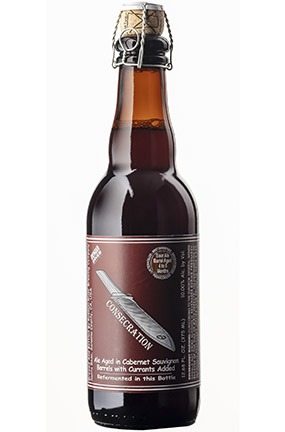
(5 gallons/19 L, all-grain)
OG = 1.067 FG = 1.012
IBU = 24 SRM = 21 ABV = 7.25%*
*ABV is for the base beer prior to barrel aging with fruit. The final ABV after aging with fruit and accounting for evaporation is 10%.
Of all the beers I have presented in this BYO recipe package, Consecration is probably the most difficult to brew due to its unique process of being aged in used Cabernet Sauvignon wine barrels. Consecration is a dark ale that is initially fermented with Belgian Abbey Ale yeast. After the beer is done fermenting and all the primary yeast is removed, the beer goes into barrels (this homebrew version calls for oak chips, for ease) with dried currants and Brettanomyces yeast initially. After 2–3 months, the bacteria is added. All of this is left to age in the barrel until it is ready to rack off the fruit and be packaged. – Vinnie Cilurzo
Ingredients
9.3 lbs. (4.2 kg) 2-row pale malt
10 oz. (285 g) unmalted wheat
6 oz. (170 g) acidulated malt
4 oz. (113 g) Special B® malt
4 oz. (113 g) Carafa® III Special malt
1.25 lbs. (0.57 kg) dextrose sugar
8 oz. (14 g) dark candi syrup
11 AAU Warrior hops (60 min.) (0.65 oz./18 g at 16.9% alpha acids)
2 oz. (56 g) aged hops (30 min.)
4.5 oz. (128 g) aged hops (whirlpool)
3 lbs. (1.4 kg) dried currants
Oak chips soaked in Cabernet Sauvignon
White Labs WLP530 (Abbey Ale), Wyeast 3787 (Trappist High Gravity), or Imperial Yeast B48 (Triple Double) yeast
Brettanomyces bruxellensis (such as Omega Yeast OYL-202, Wyeast 5112, White Labs WLP650, or similar)
Lactobacillus (such as Omega Yeast OYL-605, Wyeast 5335, White Labs WLP672, or similar)
Pediococcus damnosus (such as Omega Yeast OYL606, Wyeast 5733, White Labs WLP661, or similar)
Step by step
Mash the grains at 160 °F (71 °C) for 60 minutes, targeting a mash pH of 5.35–5.45. Conduct a 170 °F (77 °C) mash out step, if desired. Vorlauf until your wort is clear, then run off into the kettle. Sparge the grains with 168 °F (76 °C) water to obtain 6 gallons (23 L) of wort (or more, depending on your evaporation rate).
Boil for 60 minutes following the hopping schedule. Add the dextrose and candi syrup with 15 minutes remaining. After the boil is complete, add the whirlpool hop additions and stir the wort briskly to form a whirlpool, then cover and let stand for 15 minutes. Russian River adjusts the pH in the whirlpool down to 5.0–5.1.
Chill the wort to slightly below fermentation temperature, about 64–66°F (18–19 °C). Aerate the wort if using a liquid yeast strain, pitch about half as much of the Belgian ale yeast as normal. Ferment at 68 °F (20 °C) until final gravity is achieved and let the beer sit for one to two additional days.
If possible, remove yeast from fermenter and fine the beer with biofine or gelatin to remove as much yeast as possible. Russian River ages Consecration in freshly emptied Cabernet Sauvignon barrels. Their process looks like this: Add currants and Brettanomyces directly to the barrel and transfer the beer on top. After 8–12 weeks, add the Lactobacillus and Pediococcus to the barrel. The beer will need to sit for another 6–8 months to complete a secondary fermentation. The final gravity should be around 1.002–1.004 depending on how vigorous the secondary fermentation is in the barrel.
If you don’t have access to a used wine barrel, use oak chips and soak them in your favorite Cabernet Sauvignon and use those in the beer. Before doing this, boil the oak chips or soak the oak chips first in a citric acid solution and then rinse them to try to remove some of the oak character. You’d want to do this several times to reduce the oak contribution to the beer. Consecration does not have a strong oak character as the used Cabernet Sauvignon barrels have had wine in them for a minimum of three years.
Extract with grains version:
Replace the 2-row, wheat, and acidulated malt with 6.6 lbs. (3 kg) light liquid malt extract, 7 oz. (200 g) dry wheat malt extract and ¾ tsp. 88% lactic acid. Add 6.5 gallons (24.5 L) water to your brew kettle and bring to a boil. Remove kettle from heat and carefully stir in the liquid and dry malt extracts until totally dissolved. Add the lactic acid and return to the heat and boil for 60 minutes. Follow the remainder of the all-grain recipe.
Notes from Vinnie:
As you can see from the recipe, we conduct a high-temperature mash. The purpose for this is to create a good amount of unfermentable sugars for the Brettanomyces and bacteria to work on down the line. You’ll want to pitch 50% of your normal yeast pitch to this beer. This is another way we ensure we leave enough residual extract in the beer for the Brettanomyces and bacteria.
Ultimately, Consecration is a balance of aromas and flavors contributed from the malt, hops, yeast, bacteria, barrel (oak), and fruit. My initial thought with this beer was to have flavors from the beer that would meld nicely with the characteristics from the wine that was once in the barrel. There really should be no one overpowering flavor to the beer.
